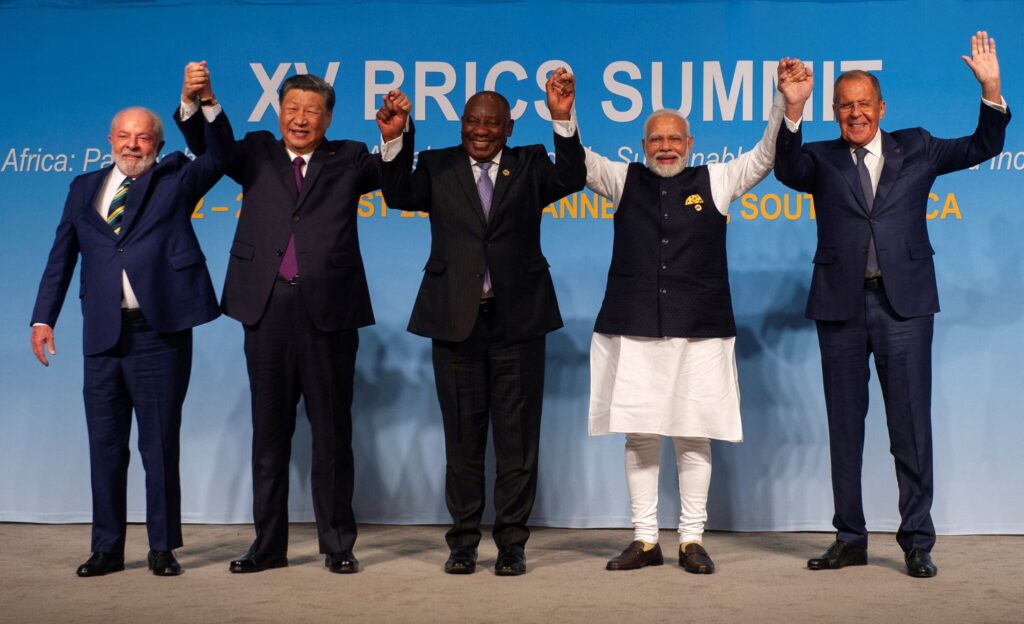-
The BRICS nations purposefully switch economic transactions from the US currency to cryptocurrencies to promote their currencies.
-
The BRICS Pay system and Central Bank Digital Currencies (CBDCs) are crucial in facilitating this shift.
-
Sergey Ryabkov describes how the “BRICS Bridge.” can promote financial integration and speed up BRICS transactions.
Chairman of the Russian State Duma Committee on the Financial Market, Anatoly Aksakov, recently underlined a significant turning point in the dynamics of the world economy.
Aksakov revealed that the countries of the BRICS had purposefully switched their commercial transactions from the US dollar to cryptocurrencies.
BRICS embraces Central Bank digital currencies for trade, paving the way for a dollar-less future.
This historic occasion shows the BRICS countries’ coordinated attempts to reduce their reliance on the US dollar and promote the use of their currencies in international trade.
Since its founding, the goal of the BRICS (Brazil, Russia, India, China, and South Africa) alliance has been to diversify away from the dollar’s hegemony. Projects like the BRICS Pay system are leading the push to encourage the use of virtual currencies.
By emphasizing the use of local currency in bilateral transactions more, the BRICS countries have dramatically changed the global economic scene in the last year. With this audacious move towards integrating cryptocurrencies, the alliance hopes to show even more of its independence and tenacity in the face of challenging times in the world economy.
The BRICS Bridge initiative aims to adopt a unique strategy by focusing on developing Central Bank Digital Currencies (CBDCs) as an alternative to fiat money. This starkly contrasts the Western world’s skepticism towards such endeavors. Together with the BRICS countries detaching themselves from the US dollar, this calculated action creates the groundwork for a more robust and autonomous financial system.
Russian Deputy Foreign Minister Sergey Ryabkov presented several strategies for creating a new financial system that will facilitate the use of digital assets and advance the creation of better trade routes among the BRICS countries.
One idea, a “BRICS Bridge,” seeks to improve financial integration and speed transactions inside the alliance. The member states’ economic systems would be linked together using stablecoins or other forms of digital currency.
Though these changes mark a dramatic break from the norm regarding trade dynamics, worries about possibly removing the US currency from international transactions with BRICS nations still linger. Nevertheless, the idea of a world without dollars seems to be becoming more realistic as the alliance gets closer to securing autonomous trade agreements and developing creative financial solutions.
ALSO, READ: Key takeaways from African Presidents at the 15th BRICS summit.
Cryptocurrencies among the BRICS nations might promote more significant economic growth and financial inclusion among citizens. Furthermore, using cryptocurrency defies the convention of fiat money.
The organization aims to reduce transaction costs, improve financial service accessibility, and provide official banking services to economically disadvantaged people. This transition to digital currency and Central Bank digital currencies is consistent with the alliance’s goal of promoting sustainable and fair development in various socioeconomic settings.
BRICS is aware of the associated dangers and challenges as it enters the trade market for digital currency issued by the Central Bank of Korea. Possible difficulties, including volatility, cybersecurity risks, and ambiguous regulations, are ahead.

Even so, the BRICS countries are cooperating to establish solid regulatory frameworks and guarantee the integrity and stability of their financial systems to eradicate these risks. The involved countries are trying to find early answers to issues to promote trust in cryptocurrencies as a trustworthy means of wealth storage and payment.
The BRICS countries’ use of cryptocurrencies shows a more profound dedication to promoting creativity and technical progress within their borders. The BRICS economies are funding blockchain technology research and development and digital infrastructure to put themselves in the vanguard of the digital revolution.
In addition to making member economies more competitive, this proactive attitude towards innovation encourages entrepreneurship and the creation of jobs in rapidly expanding sectors like fintech and digital finance.
The fact that the BRICS countries’ attitude towards a dollar-less future affects them outside of the alliance suggests a fundamental reorganization of the dynamics of the global economy.
The BRICS Bridge initiative is gaining more clout on the global scene as it seeks to establish cooperative alliances with other countries and organizations that share its vision of a more inclusive and equitable financial system.
The BRICS countries want a multipolar world order distinguished by more diversity, resilience, and riches. They want to get there by encouraging communication and cooperation.
Finally, the alliance can withstand and remain independent in a fast-changing financial environment. Moreover, the alliance’s commercial use of cryptocurrency indicates a paradigm shift in global economic ties among nations.
By de-dollarizing and promoting digital currencies, the BRICS countries are paving the way for a time when their members will cooperate, increase efficiency, and increase financial inclusion.
Also, READ: BRICS admits six countries to the bloc and seeks to boost local currency lending.
